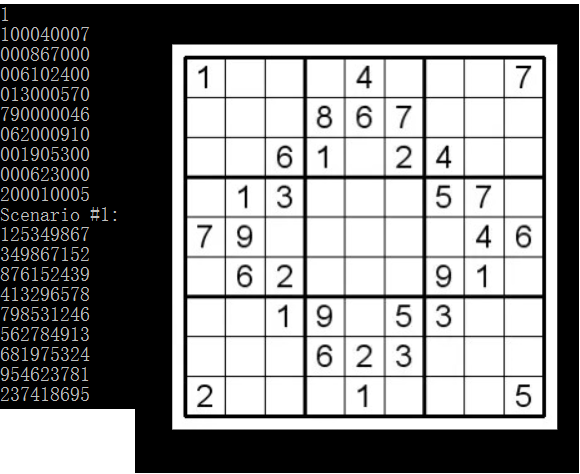#include<cstdio>
#include<cstring>
#include<vector>
using namespace std;
const int maxr = 5000;
const int maxn = 2000;
const int maxnode = 20000;
struct DLX {
int n, sz;
int S[maxn];
int row[maxnode], col[maxnode];
int L[maxnode], R[maxnode], U[maxnode], D[maxnode];
int ansd, ans[maxr];
void init(int n) {
this->n = n;
for(int i = 0 ; i <= n; i++) {
U[i] = i; D[i] = i; L[i] = i-1, R[i] = i+1;
}
R[n] = 0; L[0] = n;
sz = n + 1;
memset(S, 0, sizeof(S));
}
void addRow(int r, vector<int> columns) {
int first = sz;
for(int i = 0; i < columns.size(); i++) {
int c = columns[i];
L[sz] = sz - 1; R[sz] = sz + 1; D[sz] = c; U[sz] = U[c];
D[U[c]] = sz; U[c] = sz;
row[sz] = r; col[sz] = c;
S[c]++; sz++;
}
R[sz - 1] = first; L[first] = sz - 1;
}
#define FOR(i,A,s) for(int i = A[s]; i != s; i = A[i])
void remove(int c) {
L[R[c]] = L[c];
R[L[c]] = R[c];
FOR(i,D,c)
FOR(j,R,i) { U[D[j]] = U[j]; D[U[j]] = D[j]; --S[col[j]]; }
}
void restore(int c) {
FOR(i,U,c)
FOR(j,L,i) { ++S[col[j]]; U[D[j]] = j; D[U[j]] = j; }
L[R[c]] = c;
R[L[c]] = c;
}
bool dfs(int d) {
if (R[0] == 0) {
ansd = d;
return true;
}
int c = R[0];
FOR(i,R,0) if(S[i] < S[c]) c = i;
remove(c);
FOR(i,D,c) {
ans[d] = row[i];
FOR(j,R,i) remove(col[j]);
if(dfs(d+1)) return true;
FOR(j,L,i) restore(col[j]);
}
restore(c);
return false;
}
bool solve(vector<int>& v) {
v.clear();
if(!dfs(0)) return false;
for(int i = 0; i < ansd; i++) v.push_back(ans[i]);
return true;
}
};
#include<cassert>
DLX solver;
const int SLOT = 0;
const int ROW = 1;
const int COL = 2;
const int SUB = 3;
int encode(int a, int b, int c) {
return a*256+b*16+c+1;
}
void decode(int code, int& a, int& b, int& c) {
code--;
c = code%16; code /= 16;
b = code%16; code /= 16;
a = code;
}
char puzzle[16][20];
bool read() {
for(int i = 0; i < 16; i++)
if(scanf("%s", puzzle[i]) != 1) return false;
return true;
}
int main() {
int kase = 0;
while(read()) {
if(++kase != 1) printf("\n");
solver.init(1024);
for(int r = 0; r < 16; r++)
for(int c = 0; c < 16; c++)
for(int v = 0; v < 16; v++)
if(puzzle[r][c] == '-' || puzzle[r][c] == 'A'+v) {
vector<int> columns;
columns.push_back(encode(SLOT, r, c));
columns.push_back(encode(ROW, r, v));
columns.push_back(encode(COL, c, v));
columns.push_back(encode(SUB, (r/4)*4+c/4, v));
solver.addRow(encode(r, c, v), columns);
}
vector<int> ans;
assert(solver.solve(ans));
for(int i = 0; i < ans.size(); i++) {
int r, c, v;
decode(ans[i], r, c, v);
puzzle[r][c] = 'A'+v;
}
for(int i = 0; i < 16; i++)
printf("%s\n", puzzle[i]);
}
return 0;
}
